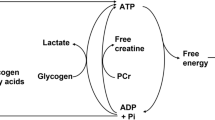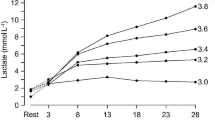Summary
Following earlier papers that established the mathematical form of the time dependence of lactate concentrations during recovery from several types of exercise, and that set up a two-compartment model predicting the same time dependences, the present work applies the model to obtain parameters of specific physiological processes. Satisfactory agreement between predictions of the model and our experiment and literature data is obtained in the cases where comparisons can be made, as in the muscular lactate time evolution measured from biopsy samples, in blood flows through the active muscle at the end of exercise or at rest and their evolution during recovery, as well as in the volume of the active muscle compartment. The model prediction that lactate efflux from the muscles to the blood can reduce to zero during recovery is verified experimentally.
Similar content being viewed by others
Abbreviations
- A 1, A 2 :
-
Amplitudes of the two exponential terms fitted to arterial lactate concentrations (Μmol·1−1)
- α 12, α 21 :
-
Transfer coefficients from (M) to (S) and (S) to (M) respectively (min−1)
- A D :
-
Area of the body according to Dubois (m2)
- BM :
-
Body mass (kg)
- C 1, C 2 :
-
Amplitudes of the exponential terms of L m (t) (Μmol·1−1)
- c 1, d 1 :
-
Rates of lactate production in (M) and (S), respectively (Μmol·min−1)
- c 2, d 2 :
-
Coefficients of lactate disappearance in (M) and (S) respectively (min−1)
- F 1 :
-
Field of validity of the model (see [32])
- γ 1, γ 2 :
-
Velocity constants of the exponential terms fitted to arterial lactate concentrations (min−1)
- L a (t):
-
Arterial lactate concentration at time t (mmol·1−1 or Μmol·1−1)
- L a max:
-
Maximum arterial lactate concentration of the recovery (mmol·1−1)
- L fv (t):
-
Femoral venous blood lactate concentration at time t (mmol·−1)
- L M (t), L S (t):
-
Lactate concentrations in (M) and (S), respectively at time t (mmol·1−1 or Μmol·1−1)
- (M):
-
Working or active muscle space
- q(t) :
-
Blood flow through (M) at time t (ml·100 ml−1·min−1)
- Φ MS (t):
-
Rate of net lactate release from (M) to (S) at time t (mmol·min−1)
- Μ :
-
Rate of net lactate release from (M) to (S) at t→∞(Μmol·min−1)
- (S):
-
Remaining lactate space
- t :
-
Time after the end of exercise (min)
- θ, θ′ :
-
Moments at which the net lactate release from (M) to (S) becomes zero (min)
- θ 2 :
-
Moment of the intersection of the arterial and brachial venous blood lactate curves (min)
- θ fa1, θ fa2 :
-
Moments of the intersection of the arterial and femoral venous blood lactate curves (min)
- V M , V s , V TLS :
-
Volume of (M), (S), and (TLS), respectively, [1]
- (TLS):
-
Total lactate space
- ε :
-
Difference between L M (∞) and L s (∞)
References
Ahlborg G, Hagenfeldt L, Wahren J (1975) Substrate utilization by the inactive leg during one-leg or arm exercise. J Appl Physiol 39: 718–723
Bergström J, Guarnieri G, Hultman E (1971) Carbohydrate metabolism and electrolyte changes in human muscle tissue during heavy work. J Appl Physiol 30: 122–125
Bonde-Petersen F, Henriksson J, Lundin B (1975) Blood flow in thigh muscle during bicycling exercise at varying work rates. Eur J Appl Physiol 34: 191–197
Cerretelli P, Sikand R, Fahri LE (1966) Readjustments in cardiac output and gas exchange during onset of exercise and recovery. J Appl Physiol 21: 1345–1350
Diamant B, Karlsson J, Saltin B (1968) Muscle tissue lactate after maximal exercise in man. Acta Physiol Scand 72: 383–384
Donald KW, Wormald PN, Taylor SH, Bishop JM (1957) Changes in the oxygen content of femoral venous blood and leg blood flow during leg exercise in relation to cardiac output response. Clin Sci 16: 567–591
Ekblom B, Hermansen L (1968) Cardiac output in athletes. J Appl Physiol 25: 619–625
Essen B, Jansson E, Henriksson J, Taylor AW, Saltin B (1975) Metabolic characteristics of fibre types in human skeletal muscle. Acta Physiol Scand 95: 153–165
Freund H, Gendry P (1978) Lactate kinetics after short strenuous exercise in man. Eur J Appl Physiol 39: 123–135
Freund H, Zouloumian P (1981) Lactate after exercise in man: I. Evolution kinetics in arterial blood. Eur J Appl Physiol 46: 121–133
Gollnick PD, Piehl K, Saubert CW, Armstrong RB, Saltin B (1972) Diet, exercise and glycogen changes in human muscle fibers. J Appl Physiol 33: 421–425
Hagenfeldt L, Wahren J (1972) Human forearm muscle metabolism during exercise. VII. FFA uptake and oxydation at different work intensities. Scand J Clin Lab Invest 30: 429–436
Harris RC, Sahlin K, Hultman E (1977) Phosphagen and lactate contents of m. quadriceps femoris of man after exercise. J Appl Physiol 43: 852–857
Hermansen L, Maehlum S, Pruett EDR, Vaage O, Waldum H, Wessel-Aas T (1975) Lactate removal at rest and during exercise. In: Howald H, Poortmans JR (eds) Metabolic adaptation to prolonged physical exercise. BirkhÄuser, Basel, pp 101–105
Hermansen L, Stensvold I (1972) Production and removal of lactate during exercise in man. Acta Physiol Scand 86: 191–201
Hermansen L, Vaage O (1977) Lactate disappearance and glycogen synthesis in human muscle after maximal exercise. Am J Physiol 233: E422-E429
Hughes RL, Clode M, Edwards RHT, Goodwin TJ, Jones NL (1968) Effect of inspired O2 on cardiopulmonary and metabolic responses to exercise in man. J Appl Physiol 24: 336–347
Jorfeldt L, Juhlin-Dannfeldt A, Karlsson J (1978) Lactate release in relation to tissue lactate in human skeletal muscle during exercise. J Appl Physiol 44: 350–352
Karlsson J (1971) Lactate and phosphagen concentrations in working muscle of man. Acta Physiol Scand 81: [Suppl] 358
Karlsson J, Nordesjö LO, Jorfeldt L, Saltin B (1972) Muscle lactate, ATP and CP levels during exercise after physical training in man. J Appl Physiol 33: 199–203
Knuttgen HG, Saltin B (1972) Muscle metabolites and oxygen uptake in short-term submaximal exercise in man. J Appl Physiol 32: 690–694
McGrail JC, Bonen A, Belcastro AN (1978) Dependence of lactate removal on muscle metabolism in man. Eur J Appl Physiol 39: 89–97
Rowell LB (1974) Human cardiovascular adjustments to exercise and thermal stress. Physiol Rev 54: 75–159
Sahlin K, Harris RC, Nylind B, Hultman E (1976) Lactate content and pH in muscle samples obtained after dynamic exercise. Pflügers Arch 367: 143–149
Saltin B, Wahren J, Pernow B (1974) Phosphagen and carbohydrate metabolism during exercise in trained middle-aged men. Scand J Clin Lab Invest 33: 71–77
Searle GL, Cavalieri RR (1972) Determination of lactate kinetics in the human analysis of data from single injection versus continuous infusion methods. Proc Soc Exp Biol (NY) 139: 1002–1006
Stenberg J, Astrand PO, Ekblom B, Royce J, Saltin B (1967) Hemodynamic response to work with different muscle groups, sitting and supine. J Appl Physiol 22: 61–70
Tesch P, Sjödin B, Karlsson J (1978) Relationship between lactate accumulation, LDH activity, LDH isozyme, and fibre type distribution in human skeletal muscle. Acta Physiol Scand 103: 40–46
Tesch P, Sjödin B, Thorstensson A, Karlsson J (1978) Muscle fatigue and its relation to lactate accumulation and LDH activity in man. Acta Physiol Scand 103: 413–420
Wahren J, Felig P, Hagenfeldt L, Hendler R, Ahlborg G (1975) Splanchnic and leg metabolism of glucose, free fatty acids, and amino acids during prolonged exercise in man. In: Howald H, Poortmans JR (eds) Metabolic adaptation to prolonged physical exercise. BirkhÄuser, Basel, pp 144–153
Zouloumian P, Freund H (1981) Lactate after exercise in man. II. Mathematical model. Eur J Appl Physiol 46: 135–147
Zouloumian P, Freund H (1981) Lactate after exercise in man. III. Properties of the compartment model. Eur J Appl Physiol 46: 149–160
Author information
Authors and Affiliations
Rights and permissions
About this article
Cite this article
Freund, H., Zouloumian, P. Lactate after exercise in man: IV. Physiological observations and model predictions. Europ. J. Appl. Physiol. 46, 161–176 (1981). https://doi.org/10.1007/BF00428868
Accepted:
Issue Date:
DOI: https://doi.org/10.1007/BF00428868




